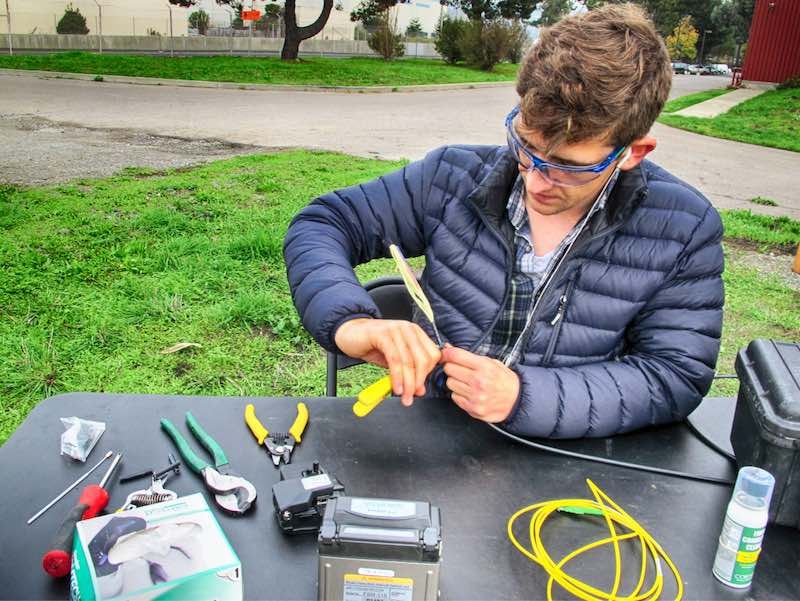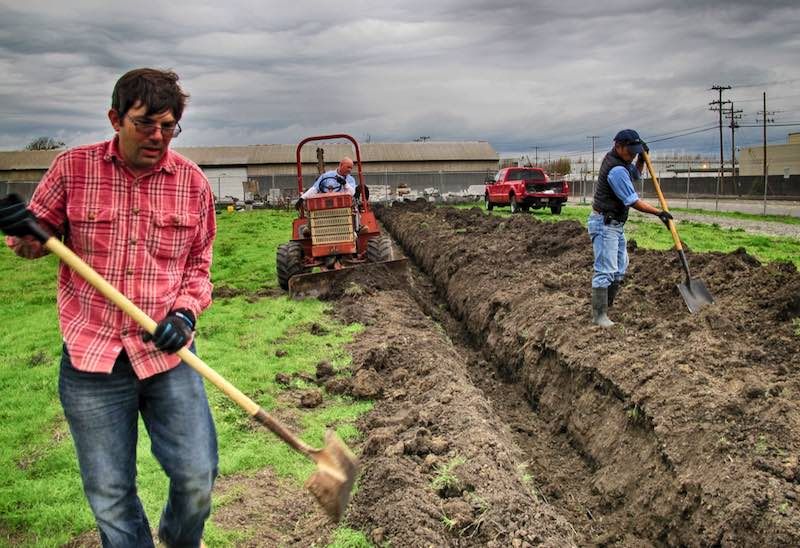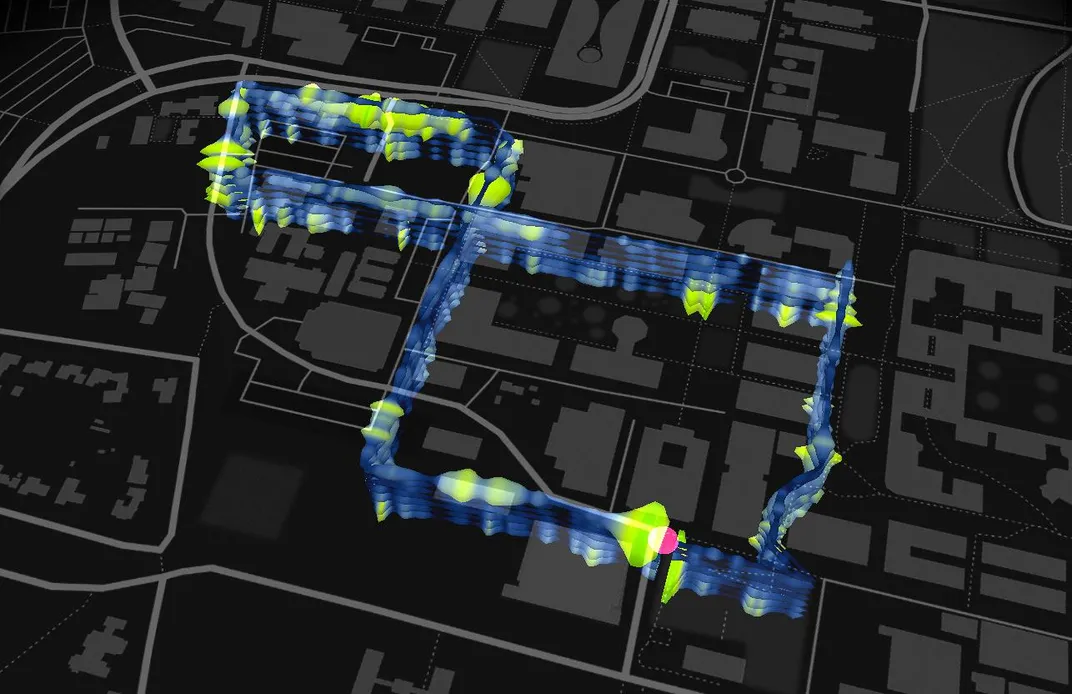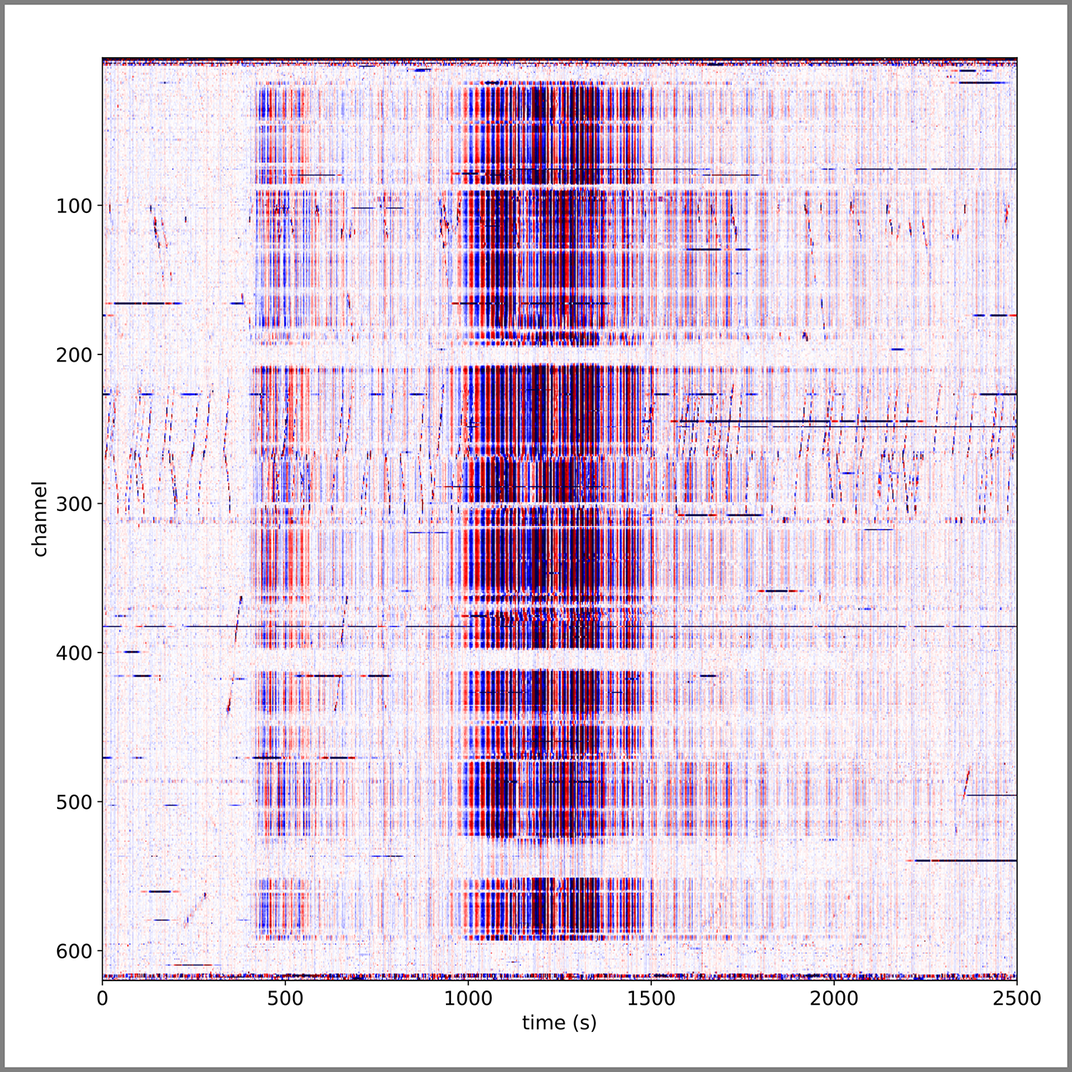Could Fiber Optics Detect Earthquakes?
By monitoring every grumble, shiver and burp our planet makes, researchers hope to be more prepared to take action when things go awry
/https://tf-cmsv2-smithsonianmag-media.s3.amazonaws.com/filer/1f/0e/1f0e2392-b4ec-4ce3-a72e-b52bf05bd30c/lbnl-dark-fiber-group-1000px.jpg)
Three neat towers of hard drives stand on Shan Dou's desk. Filled in just a few months, they contain some 500 terabytes of seismic data. It's a mind-bogglingly massive amount of data to collect and process—slightly more than the amount currently held in the national repository of seismic data, which has an archive dating back to 1970.
Where's all this information pouring in from? The answer lies beneath your feet: fiber optics.
Dou is a postdoctoral researcher at Lawrence Berkeley National Laboratory working to put the thousands of miles of fiber optic cables that traverse the globe to use in geohazard awareness—monitoring landslides, permafrost slumps, sinkholes and even changes in injected carbon dioxide. But in a new study, based on Dou’s foundational work and published last month in the journal Geophysical Research Letters, researchers homed in on the potential and versatility of the fibers to detect one particular hazard: earthquakes.
To detect the tiny tremors in the ground, researchers commonly use sensitive instruments called seismometers. But each of these units can be expensive to install and difficult to maintain. And they're not always feasible to use, explains Nate Lindsey, a PhD student at the University of California, Berkeley's Seismological Lab and lead author on the new study. "There are areas where it might be important to put a seismometer—I'm thinking offshore, I'm thinking urban areas—where it's...difficult from a logistical standpoint and from a security standpoint," he says.

That's where fiber optics—and the mountains of data—come in. Thousands of fiber optic lines traverse our country, even extending into the oceans. So if researchers can harness this system for earthquake monitoring, it offers an unprecedented amount of information, says Dou, who worked with Lindsey at UC Berkeley while finishing up her PhD.
The idea is fairly simple. Many fiber optic companies install more fiber optic cables than they need, resulting in a system of so-called "dark fibers"—fibers bundled in underground conduits—that could be employed for alternative purposes, such as earthquake sensing. But each of these fiber optic lines is imperfect. When you beam a light down the individual fiber optic strands, these imperfections in the structure bounce back a fraction of the light. Researchers can affix what's known as a laser interferometer at one end of the line to send and measure changes in these returned glimmers, discerning minute compressions or extensions of the cables due to vibrations of the ground.
“Every meter of optical fiber in our network acts like a sensor and costs less than a dollar to install,” Biondo Biondi, a geophysicist at Stanford and author of the new paper, says in a press release. “You will never be able to create a network using conventional seismometers with that kind of coverage, density and price.”
"That's the beauty of it,” Dou explains, “We don't have to make anything special, just buy something that's already widely available for telecommunications."
But figuring out exactly how to use those fibers for earthquake detection takes a little bit more work. One big unknown is sensitivity. This use of fiber optics for measuring vibrations in the ground emerged from the oil and gas industry, which used the lines to monitor pipelines and wells—by doing things like listening for the rumble of approaching vehicles. But for these purposes, the fiber optics are usually “coupled,” or cemented in the ground, resulting in a more efficient transfer of Earth's grumbles and shakes to the fibers.
“People didn’t believe this would work,” says Eileen Martin, a graduate student in Biondi’s lab and another author on the paper. “They always assumed that an uncoupled optical fiber would generate too much signal noise to be useful.” But initial tests conducted as a collaboration between Stanford, UC Berkeley and Berkeley National Lab are promising.
The UC Berkeley researchers have been working on using fiber optics to monitor the subsurface for five years, recording ambient noises like passing cars with the fibers to study the changes in important features, such as the water table. (In September, the team published this work in collaboration with scientists at the U.S. Army Cold Regions Research & Engineering Laboratory in Alaska and Stanford University in the journal Scientific Reports.) For the new study of fiber optic potential for earthquake monitoring, the scientists compared earthquake observations using three different fiber optic arrays, including buried fiber optic lines near Fairbanks, Alaska, buried L-shaped lines in Richmond, California, and a figure-8 loop installed in an existing telecommunications conduit running under Stanford’s campus.

The team has recorded a range of events in all three systems. In the Stanford loop alone, researchers have cataloged more than 800 temblors since data collection began in September 2016, picking out the signals in data after the events pass. "We can see them from Mexico, from Italy, from Oklahoma...as well as teeny tiny ones on the Stanford campus," says Biondi.

Overall the results are encouraging. As Biondi says, "potentially all the pieces are there," but more work needs to happen to put the system in action.
Currently, Lindsey and his team are testing out the capabilities of fiber optics in 13-miles of dark fiber in Sacramento, California, owned by the company Level 3 Communications, which was recently purchased by CenturyLink. They are comparing their measured signal to traditional seismometers.
"The comparison is good," says Lindsey. "There's a lot more research to be done to understand and clarify the advantages and disadvantages in fiber optic sensing. But there's signal in the fiber optic sensor that's a above the noise level, and that's useful." They are preparing a manuscript on this project to submit for publication in a peer-reviewed journal next month.
Sensitivity is still of concern for widespread application of fiber optic earthquake sensing. "For the moment, fiber tends to have lower sensitivity than conventional seismometer," Dou says. Other colleagues, she notes, are currently investigating ways to improve the fiber optic sensing capabilities. There are also a lot of unknowns about the installation conditions of existing telecommunication networks. Small tweaks, such as the number of fiber optic cables in a conduit, could influence detection and thus the fiber's ability to relay accurate information about earthquakes.
Equally as important is the need to develop methods to process and analyze such large quantities of data in real time. "It's a great playground of data to work with," says Lindsey. "But I look forward to the day when it doesn't take students suitcases of hard drives to solve this kind of problem.”
For Clay Kirkendall, a researcher with the Navy who has worked with fiber optic sensors for the last 20 years, cost remains a concern with the new system. "Certainly the fibers are already there and that is a big part of the cost," says Kirkendall, who was not part of the study. But you still need a device to bounce light down the lines and measure the returning signals—and skimping on this aspect of the system could sacrifice sensitivity, he says. It's unclear how much high-quality laser interrogators will cost at the moment, but Biondi hopes that as technology advances the cost of those systems will decline.
If the researchers can work out those kinks, fiber optics could offer a solution to the many challenges of earthquake monitoring. This tech could be particularly useful in improving systems that warn communities of nearby earthquakes to give them just a fraction of extra time to prepare for the jolt. The positive impacts—and failings—of such networks were emphasized earlier this year in Mexico's series of quakes.

The Mexican Seismic Alert System, or SASMEX, is the first early warning system to notify the public of pending earthquakes. A network of seismometers, the instrument traditionally used to monitor earthquakes, speckle sections of the country, monitoring for tremors. As soon as this network registers something large enough for potential concern, the warning goes out, which can provide anywhere from seconds to a full minute of notice on the incoming jolt.
Lindsey emphasizes that the idea is not to replace existing systems—"at its best [fiber optics] might not be as good as the best seismometer," he notes—but rather to enhance them. "We see fiber optic seismology as being a great way to complement earthquake early warning techniques, which are being built up now around the planet," he says.
Though there still is much more work to do to make this happen, teams of researchers and many universities are on the case. "This is really collectively a bigger endeavor," Dou says, noting that a team at CalTech is working on similar dark fiber projects.
"It is a rapidly developing field, and we're just lucky to be at a pioneering position," she says.
/https://tf-cmsv2-smithsonianmag-media.s3.amazonaws.com/accounts/headshot/Wei-Haas_Maya_Headshot-v2.png)
/https://tf-cmsv2-smithsonianmag-media.s3.amazonaws.com/accounts/headshot/Wei-Haas_Maya_Headshot-v2.png)